A new study on language and the brain from an Israeli university reveals why it’s harder to learn to read in Arabic than in most other languages.

Over the past 10 years, data has indicated that learning to read in Arabic is harder and takes longer than learning to read in other languages. A new study on language and the brain from Israel’s University of Haifa reveals why reading acquisition in Arabic is so challenging.
The series of studies show that reading acquisition in Arabic is much harder, in comparison to English. The researchers reveal that because of the visual complexity of Arabic orthography (method of spelling), the brain’s right hemisphere is not involved in decoding the text in the first stages of learning to read.
The graphic complexity of Arabic script seems to ‘activate’ left-brain functions. The left hemisphere of the brain is dominant for language, math and logic. The right hemisphere is dominant for spatial abilities, face recognition, visual imagery and music. Of course, in most people the two hemispheres work together.
Visual complexity causes perceptual overload
Prof. Zohar Eviatar and neuropsychologist Dr. Raphiq Ibrahim of Haifa University examined the assumption that the difficulty in learning to read Arabic is due to the visual or graphic complexity of the written Arabic system. They explain that Arabic has a number of very similar graphic symbols representing different letters and sounds, distinguished only by very slight differences such as lines or dots, as well as sounds that are represented by a variety of different symbols.
Letters such as the equivalents of B, N, TH and T, for instance, all have the same basic shape, but with a different amount of dots under or over them. F and Q are also similar, as are R and Z, and J, H, and KH.
To establish whether this complexity causes perceptual overload, the researchers carried out a series of studies comparing children’s and adults’ reading speed and accuracy for those with mother tongue Arabic, Hebrew (a language similar to Arabic) and English (a very dissimilar language to Arabic). They also examined the speed and accuracy of processing Arabic, Hebrew and English words in readers whose mother tongue is Arabic only.
Their results reveal that the right brain is involved in the reading process for English and Hebrew, but not for Arabic. The authors explain that in Arabic, identifying the number and location of dots that is critical in order to differentiate between letters, is a hard task for the right brain since that hemisphere primarily utilizes global information to identify letters.
This means that children acquiring languages other than Arabic draw on the use of both hemispheres in the first stages of learning to read, while children learning to read Arabic lack the participation of the right brain. This may mean that reading processes take longer to be ‘automatized’ in Arabic, the professors suggest.
The overall findings support the hypothesis that the complexity results in a heavy perceptual load, contributing to the difficulty and slow processing in learning to read Arabic.
More help for pupils recommended
Eviatar told reporters that when Arabic and Hebrew reading are tested in children who speak and read both, they do better in Hebrew reading than in Arabic reading, whether their mother tongue is Hebrew or Arabic.
She explains that this is because Hebrew doesn’t have the same difficulties. “It’s true that many Hebrew letters are built around similar square shapes. However, only five Hebrew letters change their shape depending on whether they end a word or not, while many Arabic letters do so, and even take on different shapes in other parts of the word.” Hebrew is a phonic language, as opposed to English. In Hebrew, letters and combinations of letters have the same sound in all word constructs.
The researchers sum up that “children who learn languages other than Arabic rely on the capabilities of both sides of their brain at the early stages of learning to read, whereas the child learning Arabic has a stronger challenge.”
Therefore, they conclude that the native Arabic-speaking child requires more practice and particular pedagogic effort. In their opinion, this demonstrates the need for systematic professional involvement in the teaching of Arabic reading, especially for those who have learning difficulties.
The studies were carried out at the Department of Psychology and the Edmond J. Safra Brain Research Center for the Study of Learning Disabilities at the University of Haifa and published in the prestigious journal Neuropsychology.












